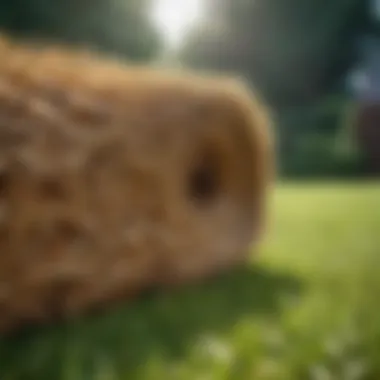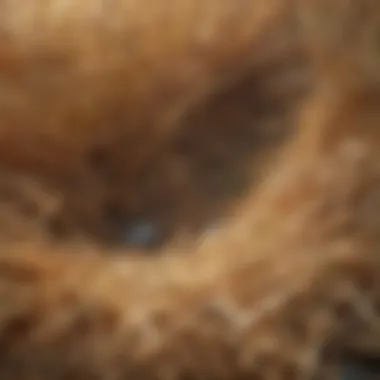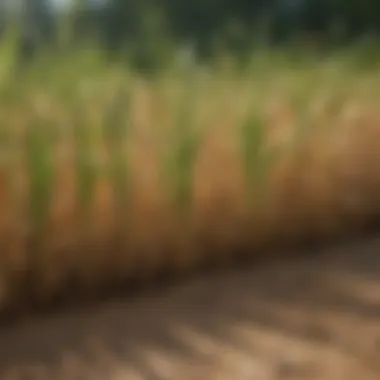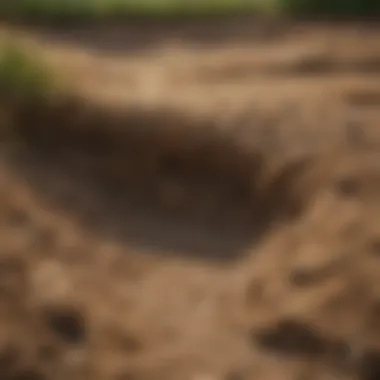Enhancing Grass Seed Germination with Straw


Intro
The practice of using straw in garden settings has gained attention over the years, especially among enthusiasts looking to optimize grass seed germination. Utilizing straw as a protective cover for newly sown grass seeds is more than just a simple gardening hack. It involves a range of processes that interplay with the natural elements, enhancing various aspects of plant growth.
Straw offers numerous benefits, such as conserving soil moisture, preventing erosion, and moderating soil temperature. Homeowners and avid gardeners alike can leverage these advantages to cultivate healthier lawns. However, as with any gardening technique, there can be potential drawbacks that one needs to consider. Understanding both sides of the equation can lead to more informed decisions in the garden.
As we unfold further on this topic, we will explore key aspects that highlight the importance of straw in the germination process. The subsequent sections will delve into the methodology, benefits, and best practices in order to ensure optimal outcomes for your grass seeds.
Prelims to Grass Seed Germination
Grass seed germination is a crucial phase in establishing a healthy and lush lawn. Understanding this process helps homeowners make informed decisions about their grass planting practices. It involves the transformation of viable seeds into seedlings, which requires the right conditions for success. Proper germination is influenced by factors such as soil quality, moisture level, and temperature.
In this article, we will explore the critical role of straw as a protective layer for grass seed. Straw can enhance seed germination by preserving moisture and promoting an optimal growth environment. This guide will delve into the best practices for employing straw, focusing on its benefits as well as common pitfalls to avoid. Through detailed insights, we aim to empower garden enthusiasts with knowledge that optimizes grass growth and leads to vibrant lawns.
Understanding Grass Seed
Grass seeds are small packages of potential, each containing the genetic blueprint for a new plant. When selecting grass seed, it is essential to consider several aspects, such as the type of grass that best suits the climate and soil conditions of the area. Cool-season grasses like Kentucky bluegrass thrive in northern climates, while warm-season varieties like Bermuda grass are better for southern regions.
The quality of grass seed is vital, as it affects germination rates and success. High-quality seeds typically have higher purity and germination rates when compared to lower-quality options. It is advisable to purchase seeds from reputable dealers, ensuring they are free from contaminants and not expired.
The Germination Process
The germination process is a series of stages that leads to the emergence of a seedling from its dormant state. Initiated by exposure to favorable conditions, including moisture, warmth, and air, seeds absorb water, activating the metabolism within. This critical stage involves several process steps:
- Imbibition: The seed absorbs water, causing it to swell. This is the first signal that leads to growth.
- Activation: Enzymes within the seed begin to break down stored nutrients, providing energy for growth.
- Cell Division: The seed starts to grow. The embryonic root, or radicle, breaks through the seed coating first, followed by the shoot.
- Emergence: Once the shoot reaches the soil surface, the process of establishing itself begins.
The success of germination relies significantly on the availability of adequate moisture and suitable temperatures.
These steps illustrate the delicate nature of germination. Poor conditions, such as compaction or inadequate watering, can hinder this process, leading to failed growth. By utilizing straw, gardeners can create a more controlled environment, protecting seeds from the elements while maintaining necessary moisture levels.
Why Use Straw on Grass Seed?
The application of straw on grass seed is a practice that offers various benefits, significantly enhancing the germination process. Using straw creates a conducive environment for seeds to sprout and establish robust roots. When we consider lawn maintenance, the choice to apply straw must align with specific gardening goals. Below are some compelling reasons why straw serves as a practical solution when planting grass seed.
Moisture Retention
Straw acts as an effective barrier that reduces evaporation. This is particularly crucial in dry climates or during times of limited rainfall. By covering the newly sown seeds, straw helps retain moisture in the soil, ensuring consistent hydration for the seeds.
- Less Watering Needed: Homeowners can reduce their water usage as the straw helps keep the soil moist.
- Improved Germination Rates: Proper moisture levels lead to improved seed germination, as seeds remain hydrated for longer periods.
The positive impact on moisture retention can lead to faster and more uniform grass growth. As a result, the lawn can develop a thicker, healthier appearance.
Erosion Prevention
Another essential benefit of straw is its ability to combat soil erosion. Erosion can occur due to rain or wind, which can wash away the topsoil where grass seeds are sown. Using straw preserves this precious topsoil, helping to secure newly planted seeds in place.
- Soil Structure Maintenance: A layer of straw creates a protective terrain, minimizing disturbance from harsh weather.
- Seed Coverage: It safeguards the seeds from being displaced, promoting better contact with the soil.
This practice not only promotes seed safety but also maintains the integrity of the soil, preventing loss of nutrients that are vital for healthy grass growth.


Reduction of Soil Temperature Fluctuations
Temperature variability can significantly impact seed germination. Straw serves as a natural insulator. It helps regulate the soil temperature, creating a stable environment for seeds. This regulation can lead to a more uniform germination process.
- Protection Against Heat: In warm conditions, straw can shield seeds from excessive heating.
- Cold Weather Insulation: In cooler climates, it can prevent soil temperatures from dropping too low, offering consistent warmth.
By stabilizing soil temperature, straw not only protects the seeds but also fosters a more favorable climate for grass growth. This leads to stronger roots and healthier grass overall.
"Utilizing straw effectively can transform the germination process, resulting in a lush, green lawn."
Organic vs. Synthetic Mulch
In the context of enhancing grass seed germination, the choice between organic and synthetic mulch plays a significant role. Understanding the distinction between these two types of mulch helps gardeners select the most suitable option for their specific needs. Organic mulch, such as straw, grass clippings, and wood chips, consist of natural materials that break down and enrich the soil. On the other hand, synthetic mulch, made from materials like plastic or rubber, does not decompose and can remain in the environment for much longer.
Advantages of Organic Mulch
Organic mulch has several benefits that can positively influence grass seed germination:
- Nutrient Release: As organic mulch decomposes, it releases nutrients back into the soil. This process enhances the soil’s fertility and provides essential elements to the growing grass.
- Moisture Conservation: Organic materials, like straw, are excellent for retaining soil moisture. This retention is crucial, especially during dry periods, as it sustains the necessary hydration for optimal seed germination and growth.
- Biodiversity Support: Using organic mulch often promotes a healthy ecosystem in the garden. It encourages beneficial organisms, such as earthworms and various microbes, which contribute to soil aeration and nutrient cycling.
- Improved Soil Structure: Over time, organic mulch improves the structure of the soil. The decomposition process helps mix organic matter with the soil, enhancing its texture. Better soil structure leads to improved drainage and root penetration for grass.
Potential Drawbacks of Synthetics
While synthetic mulch has its uses, it also comes with several drawbacks that can hinder grass seed germination:
- Heat Retention: Synthetic materials can trap heat, which may lead to excessively high soil temperatures. This can stress grass seeds and inhibit their germination process.
- Limited Nutrient Contribution: Unlike organic mulch, synthetic options do not decompose to contribute nutrients to the soil. This may require the gardener to compensate by adding fertilizers more frequently.
- Environmental Concerns: Synthetic mulch often contributes to plastic waste, which poses a significant environmental challenge. Additionally, when exposed to sunlight, synthetic materials can break down into microplastics, causing further harm to the ecosystem.
- Unnatural Appearance: Some homeowners may find synthetic mulches less aesthetically pleasing than organic options. Natural materials can blend seamlessly with the earth's palette, while synthetic ones may stand out in an unattractive way.
Selecting the Right Straw
Selecting the right straw is fundamental for the effective use of this material in grass seed germination. The type and quality of straw can significantly influence the underlying processes that support seed growth. Using suitable straw not only helps to maximize the benefits of mulching but also addresses some common challenges that may arise during the germination period. Therefore, knowing what types of straw are available and the factors influencing their selection is critical for gardening enthusiasts looking to establish a lush lawn.
Types of Straw Available
When considering straw for grass seed application, it is essential to understand the different types that one can select from. Here are several common varieties:
- Wheat Straw: This is one of the most popular choices due to its lightweight nature and availability. It decomposes gradually, providing nutrients to the soil, and also offers excellent moisture retention.
- Barley Straw: Similar to wheat, barley straw also aids in moisture maintenance while being slightly coarser. It can provide similar benefits in terms of erosion control.
- Oat Straw: Oat straw, often considered less robust, still serves as a viable option. It breaks down faster than other types and can enrich the soil with organic matter more quickly.
- Rye Straw: Rye straw tends to be more resilient and can offer better protection against soil erosion, making it suitable in windy areas or on slopes.
Each type has its unique attributes, which can benefit seed germination in different soil and weather conditions. Understanding these distinctions assists gardeners in making informed choices.
Factors to Consider
Selecting the right straw involves assessing several factors that impact its performance throughout the germination phase. Here are some considerations:
- Source Quality: Ensure that the straw comes from reputable sources to avoid contamination. Poor-quality straw may have unwanted seeds or chemicals that could hinder grass growth.
- Cutting Timing: The time of harvest greatly impacts the straw's nutrient content. Straw cut before the grain matures usually retains more nutrients and moisture.
- Decomposition Rate: Different straw types break down at various rates. Choosing a straw that aligns with your desired timeline for soil enrichment is important. Slow-decomposing straw may provide lasting benefits for extended periods, while faster-decomposing varieties can add nutrients more quickly.
- Physical Characteristics: Consider the texture and thickness of the straw. Coarser varieties might offer better erosion control but can impede seedling emergence. A balance between erosion prevention and seed access to light and air is necessary.
Choosing the appropriate straw is not simply a matter of preference; it requires a thoughtful approach based on your specific gardening context. By recognizing the diverse options and evaluating them against essential factors, one can enhance the probability of successful grass seed germination and growth.
How to Apply Straw Over Grass Seed
Applying straw effectively over grass seed is essential for promoting successful germination. It forms a protective layer, retaining moisture and minimizing environmental stresses. Understanding the approaches to applying straw can ensure that newly planted seeds have the best chance for thriving growth.


Preparation of the Soil
Before applying straw, the soil demands thorough preparation. Start by removing any debris, rocks, or weeds to create a clean surface for seeding. Next, tilling the soil helps break up compacted areas. This action improves aeration and allows for better seed-soil contact. Once tilling is complete, gently level the soil to achieve an even seed bed. This facilitates uniform coverage of the straw once the seeds are sown. After leveling, it is beneficial to rake the surface lightly. This enhances the seed's chances of making good contact with the soil, which is crucial for germination.
Best Application Techniques
Once the soil is prepared, it's time to focus on how to apply the straw. The ideal way is to distribute straw in a uniform layer over the grass seed. Hand broadcasting or using a straw blower can be effective methods. For manual application, take handfuls of straw and spread it evenly, ensuring not to pile it in one spot. For larger areas, a straw blower may help achieve a more even application. It is advisable to avoid big clumps, as they can suffocate seeds beneath them.
Remember that the application should not be too thick. A thin layer allows sunlight to penetrate while also protecting the seeds beneath. This technique minimizes competition for moisture and nutrients between seeds and the straw.
Determining Straw Thickness
Straw thickness is a crucial factor in the effectiveness of the coverage. Applying too much straw can hinder germination by blocking sunlight and suffocating the seeds. Therefore, aim for a thickness that promotes both moisture retention and light access. A good rule of thumb is to keep the straw layer between 1 to 2 inches. Adjust this thickness based on environmental conditions and specific grass types. Warmer climates might benefit from the thinner layer, while cooler regions could suit a slightly thicker application.
It’s critical to find balance. The right amount of straw can safeguard new seeds without hindering their growth potential.
By following these guidelines for soil preparation, application techniques, and determining proper straw thickness, homeowners and gardening enthusiasts can significantly improve their chances for a successful lawn establishment.
Monitoring Grass Seed Growth
Monitoring the growth of grass seeds is crucial to understanding their development and the effectiveness of the straw application. Successful germination leads to a robust lawn that thrives and resists various environmental factors. Thus, being proactive in observing this growth can present significant benefits to novice and experienced gardeners alike.
The initial phase involves monitoring seed germination, ensuring that the conditions are right for growth including moisture levels, temperature, and light. Observing these elements allows gardeners to identify any discrepancies early, helping them take corrective measures in a timely manner.
Furthermore, tracking the health of grass seedlings can provide insights into the overall effectiveness of straw as a protective layer. Straw creates a micro-environment that promotes moisture retention and can shade the young grass from extreme weather conditions.
The importance of monitoring cannot be overstated: it equips garden enthusiasts with the information necessary to foster a flourishing lawn.
Identifying Successful Germination
Successful germination can be identified through specific indicators. The long-term viability of grass seed lies within its ability to sprout within certain conditions. Here are key signs that germination is successful:
- Seed Sprouting: Tiny shoots breaking through the soil surface is the most apparent sign of life.
- Leaf Emergence: Young grass will begin to produce leaves shortly after sprouting. Healthy green leaves indicate vigor.
- Growth Rate: Monitoring growth rates can provide clues about health; rapid growth typically is a positive sign.
"The best way to monitor grass seed growth is through direct observation and regular checks on soil moisture and seedling health."
In addition to these visual cues, gardeners can conduct soil tests to gauge nutrient levels and moisture retention. This assessment helps to ensure that seedlings have everything necessary for robust growth.
Adjusting Care Techniques
Once successful germination has been confirmed, it's imperative to adjust care techniques based on observed growth patterns. Here are some methods gardeners may consider:
- Watering Adjustments: If seedlings appear too dry or overly saturated, changing the watering schedule is essential. Grass seeds require consistent moisture, but the levels should not be extreme.
- Fertilization: Depending on the soil nutrient levels, supplemental feeding may be needed to support growing seedlings. Choice of fertilizers should align with the type of grass being cultivated.
- Weed Management: Weed pressure can hinder grass growth. Applying suitable organic or chemical weed control is crucial, especially if natural competition seems excessive.
By continuously reassessing care methods, gardeners can ensure that their young grass not only establishes well but also grows into a vibrant lawn. This ongoing effort complements the fundamental umbrella of straw utilization, ultimately linking back to the overarching goal of nurturing healthy grass.
Common Challenges with Straw Application
When applying straw over grass seed, several challenges can arise that may hinder the intended benefits. Understanding these issues is crucial for homeowners and gardening enthusiasts looking to optimize their lawn care practices. By identifying potential problems early, it allows for effective mitigation, ensuring that the grass seed germination process is successful and leads to a vibrant lawn.


A major aspect to consider is that improperly applied straw can lead to pest attraction and mold development. Both concerns can significantly affect the health of grass seedlings, which is why addressing them is essential.
Pest Attraction
Straw, while a beneficial mulch, can attract various pests that may compromise grass seed germination. Rodents, for instance, find the warmth and shelter it provides inviting. They may dig into the straw, disturbing the soil and the freshly sown seed. This can lead to uneven seed distribution and hinder the germination rates.
Insects are another primary concern. Certain insects, like cutworms and grubs, enjoy the cover that straw offers. They can feed on seedling roots, causing significant damage. It is crucial to monitor straw application and check for signs of pest activity regularly.
To minimize pest-related issues:
- Utilize high-quality straw that is free from seeds and contaminants.
- Consider using barrier solutions, such as insect netting, to protect vulnerable seedlings from pests.
- Conduct routine inspections to identify infestations early.
Addressing pest attraction not only assures better germination rates but also supports the overall health of the emerging lawn.
Mold Development
Another challenge encountered when using straw as a mulch is the potential for mold growth. Straw can create a moist environment, especially if it is applied too thickly or if the weather conditions are humid. This dampness can lead to fungal diseases that affect grass seeds and seedlings.
Mold can block sunlight and air circulation, further stressing young plants. Once mold establishes itself, it can be difficult to eliminate, often requiring intervention. Taking steps to prevent mold growth is part of best practices for utilizing straw effectively.
Here are some suggested measures to combat mold development:
- Ensure appropriate straw thickness is maintained. A layer of one to two inches is ideal to balance moisture retention without excessive dampness.
- Allow for adequate airflow by spreading the straw evenly to prevent clumping.
- Monitor moisture levels in the soil to prevent waterlogging.
- If mold appears, consider removing the affected straw and replacing it with fresh material.
Frequently Asked Questions
This section aims to address common inquiries related to straw application on grass seed. Understanding these questions is crucial for homeowners and gardening enthusiasts who seek effective methods for enhancing grass growth. By providing detailed answers, we can further clarify best practices and potential concerns linked to using straw as coverage for newly sown seeds. Here are the key questions discussed:
What are the best times to apply straw?
The timing of straw application greatly affects its effectiveness in promoting grass seed germination. Ideally, straw should be applied immediately after sowing the grass seed. Doing so helps trap moisture, creating an ideal environment for seeds to sprout. If applied too early, straw can prevent seeds from making good contact with the soil, which can hinder germination.
Moreover, applying straw just before heavy rainfall could lead to the straw being displaced, reducing its benefits. Therefore, timing is of utmost importance. Additionally, applying straw during optimal weather conditions allows for better moisture retention as well as temperature regulation, ultimately facilitating a stronger germination process.
Can cardboard be used instead of straw?
Using cardboard as a substitute for straw is a consideration many may ponder. While cardboard has some benefits, such as improving moisture retention and reducing weed growth, it is not as effective as straw for grass seed germination. Cardboard can create a barrier that might impede germination and, if not applied properly, could lead to uneven growth.
Moreover, cardboard may not break down as favorably as straw, which contributes organically to the soil over time. If someone decides to go with cardboard, it's essential to perforate it to allow for airflow and water penetration. However, straw remains the more recommended option for its proven advantages and ease of application.
Closure on Straw Utilization
The role of straw in the process of grass seed germination cannot be overstated. As detailed throughout this article, applying straw offers numerous benefits that are critical to achieving successful grass growth. Straw acts as a protective barrier, effectively retaining moisture in the soil, which is essential for the germination of seeds. By maintaining consistent humidity levels, straw aids in creating a favorable environment for seeds to sprout, minimizing the risk of desiccation.
Additionally, straw contributes to erosion prevention. Newly sown grass seeds are particularly vulnerable on loose soil. The presence of straw holds the soil in place, reducing runoff and protecting against significant weather variations. Without this protective layer, seeds may wash away or become exposed to harsh conditions, which could derail their growth from the start.
Another important aspect is the regulation of soil temperature. Straw provides insulation, helping to maintain a stable temperature. This stability is vital because extreme heat or cold can hinder germination rates and affect seedling health.
While straw use is prominent, it is crucial to consider how appropriate application affects results. Factors such as thickness of the straw layer and timing of application play critical roles. Properly applied straw can enhance growth, while improperly managed application may lead to undesirable outcomes.
"Utilizing straw effectively transforms soil health and promotes successful grass growth, making it a key practice for gardening enthusiasts."
Final Thoughts on Grass Seed Success
In summary, achieving success in grass seed germination requires attention to detail and an understanding of environmental factors. The use of straw stands out as a fundamental practice that deserves emphasis. When integrating straw into germination processes, gardeners should focus on their specific lawn conditions and needs. This ensures that the application fosters the desired outcomes, optimizing both germination rates and overall lawn health.
Ultimately, it involves a blend of science and hands-on experience. Engaging with the land and understanding its nuances will lead to greater success in creating a beautiful and sustainable lawn.







